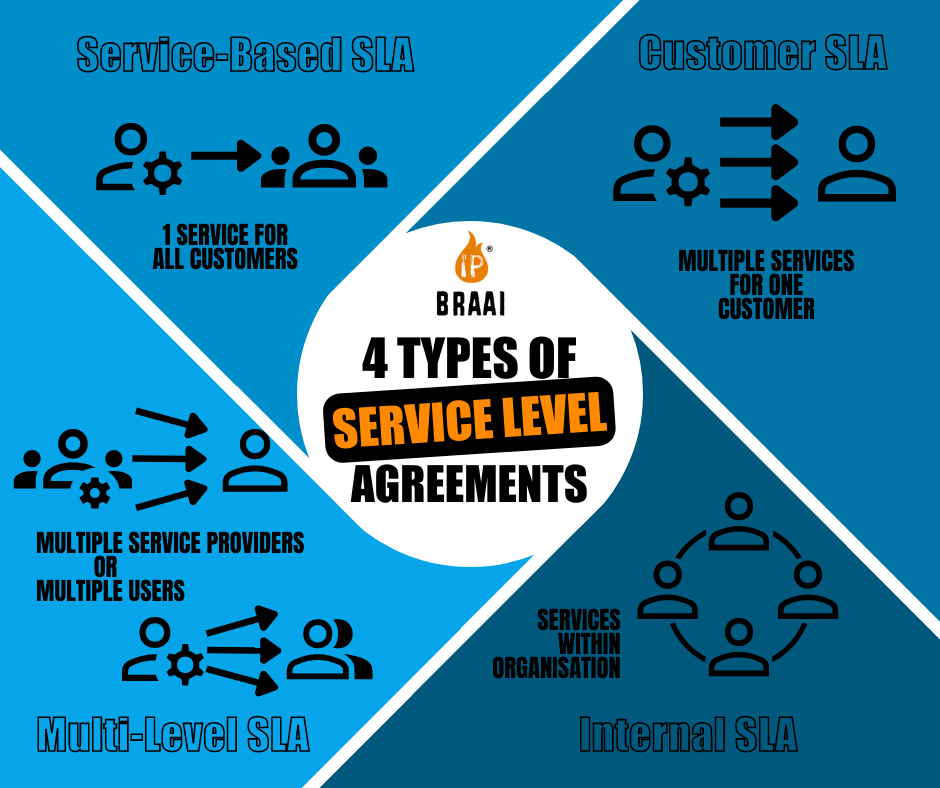You’ve had initial discussions with a third party service provider and have decided that you want to work with them. But you want to make sure that you are protected in case the services you think you have agreed to are not delivered. This is when you should enter into a Service Level Agreement (SLA). Here we’ll be going over the basics of Service Level Agreements and what a Service Level Agreement Template (South Africa) should contain.
It’s important to note that a Service Level Agreement regulates services and NOT goods.
We’re covering the following:
- What is a Service Level Agreement? How SLAs are used
- Why are Service Level Agreements important
- When can you make use of a Service Level Agreement
- Types of Service Level Agreements
- Advantages and disadvantages of Service Level Agreements
- How to create a Service Level Agreement Template (South Africa)
- What aspects should a Service Level Agreement cover
Need a Service Level Agreement Template (South Africa)?

1. What Is A Service Level Agreement? How SLAs Are Used
A Service Level Agreement is an agreement between a service provider and a customer that regulates the rights and obligations of both parties.
The customer and service provider agree on the services required, level of service, metrics, and consequences if the level of service is not met. A Service Level Agreement sets the expectations between the parties and manages service delivery. The scope of the services to be provided is defined. And the inclusions and exclusions are clearly set out.
A Service Level Agreement could be used in the following example. Let’s say that you invent a new product and approach a manufacturer. After initial discussions with the manufacturer, you decide that you want to work with them. This is the time to enter into a Service Level Agreement. The contract regulates the rights and obligations of both parties.
Sometimes these contracts are used in combination with registered Intellectual Property rights such as a Patent or Registered Design. But even in the absence of having a patent or a registered design, you have at least contractually bound the manufacturer (or other third party). So even in the absence of any statutory (registered) intellectual property rights, the SLA should aid you to enforce your rights. Check out Why Intellectual Property Protection Is Actually Just Like Special Insurance to learn more about protecting your invention.
An SLA is applicable to any service you want to measure. This could be providing security services to a residential complex, manufacturing a new braai implement, outsourced HR services, or even a food delivery service for the office lunch.
2. Why Are Service Level Agreements Important
Service Level Agreements protect both parties, i.e., the service provider and the customer. Without a Service Level Agreement, the rights and obligations of the parties are not clear. Both of you come to an agreement on expectations and consequences, and the SLA establishes this commitment.
For example, what will happen if one party does not hold up their end of the bargain? What are the expected standards? Which metrics measure service delivery? And what if the customer wants to end the contract early?
If disagreements occur, the Service Level Agreement is used as reference to clear them up.
SLAs are important for the customer to have in place because if the service provider does not meet their obligations, this could seriously affect the customer’s bottom line and/or reputation. For example, as a result, they may not be able to deliver service to their customers.
On the flip side, SLAs are just as important for the service provider. Because if the customer has unreasonable demands and there is no agreement in place, this could have serious consequences for the service provider. For example, they could be liable for huge costs if the customer demands an add-on service that is out of scope and there is no agreement in place.
How does a Service Level Agreement provide peace of mind to both parties? By clearly setting out expectations and consequences. But for the sake of both parties, it’s important to agree to realistic deliverables. For example, the time frame needs to be realistic, the frequency of the services needs to be achievable, and the metrics must be easily measured.
3. When Can You Make Use Of A Service Level Agreement
After initial discussions with a third party, if you decide that you want to work with them, you can then enter into a Service Level Agreement.
Examples of third parties include manufacturers, security providers, IT service providers, outsourcing services, software developers, professional services, or construction service providers. As you can see, a wide variety of industries use Service Level Agreements.
And if you’re starting a business and a crucial part of your business is executed externally, it is vital to clearly document that relationship and its expectations. Check out 3 Important Legal Questions to Think About When Starting a Business if you’re considering starting a business.

4. Types of Service Level Agreements
There are 4 different types of Service Level Agreements:
- Service-based SLA: This type of SLA covers one identical type of service for all customers. For example, the same pool cleaning service is provided to multiple customers.
- Customer SLA: This type of SLA is between the service provider and an individual customer, and specifies all the relevant services for that particular customer.
- Multi-Level SLA: Used in instances where there are multiple service providers or end users. For example, the service provider is providing different levels of service to various departments within the same organisation. The service provider might review Department A’s employment contracts twice annually. But the service provider only reviews Department B’s employment contracts annually.
- Internal SLA: This type of SLA is between different departments or teams in the same organization.
5. Advantages And Disadvantages Of Service Level Agreements
Advantages of Service Level Agreements:
- Both parties have legal protection.
- Aligned expectations avoid misunderstandings.
- Establishes accountability and builds trust.
- Establishes measurable guidelines.
- Full transparency means there are no surprises related to the standard of service on delivery.
- Service Level Agreements assist in building good relationships with customers because assurance is provided to customers, thereby improving the customer experience.
Disadvantages of Service Level Agreements:
- Badly drafted SLAs can be too complex, complicated, and confusing.
- SLAs could lead to excessive and unrealistic demands on the service provider.
- Very restrictive SLAs which have heavy obligations will create difficulty in working relationships and possibly lead to disputes.
- Service Level Agreements are expensive to enforce in court, and the legal process is very lengthy.
Mitigate these disadvantages by seeking the assistance of an Attorney with drafting your Service Level Agreement. And regularly review your SLAs to ensure that both parties are on the same page and that the service provider can continue to meet expectations. This will go a long way in preventing disputes.
6. How To Create A Service Level Agreement Template (South Africa)
Often, the vendor/service provider will provide the SLA. This will happen in cases when the provider has a standard service level agreement for multiple customers. However, these can be one-sided (in favour of the service provider). Therefore, clients should review the agreement before signing and preferably have it reviewed by an Attorney to highlight any concerns and avoid problems in the future.
Clearly set out the customer’s specific needs and requirements in the agreement. You should seek the help of an Attorney to draft customised, enforceable Service Level Agreement templates. This is especially crucial when intellectual property is involved.
Regularly update Service Level Agreements to incorporate all changes. Write these contracts in plain language. Why? So that all parties involved understand them and can actually adopt them in practice.
How should you establish performance metrics?
- Make sure that metrics are reasonable and practical.
- The service provider should be able to manage and control the metrics.
- Metrics must be easy to report on and obtain on a regular basis.
- Connect the metrics to the service provider’s key performance indicators (KPIs).
- Choose metrics that actually support the bottom line.

7. What Aspects Should A Service Level Agreement Template (South Africa) Cover
The contents of the agreement will depend on the industry, the service to be provided, and specific requirements. But, in general, SLAs will include most of the following:
- Scope of service required.
- Level of service required.
- State the parties to the agreement.
- Clearly set out the rights and obligations of each party.
- Metrics to measure performance. Link to the service provider’s KPIs.
- Consequences for unmet levels of service.
- Include payment requirements.
- Date of commencement and termination.
- When and how often reports are due.
- Specify how to agree to and implement changes to the SLA.
- Review frequency (monthly, bi-annually, annually, etc).
- Ownership of intellectual property.
- Clearly set out exclusions.
- Prohibition against poaching of staff (if applicable).
- Detail compensation for failure.
- Escape clause – this clause provides for early termination of the contract if service levels are unmet.
- Termination clause: The circumstances which allow for termination of the agreement, and the notice period required.
- Indemnification clause – to protect the service provider.
- Warranties: This is a promise regarding the services to be provided. Specifically, it sets the standard that the customer should expect and on which they can base a decision on whether to reject the services or pursue damages.
- Liability clause: This is a limitation of liability and indemnifies the service provider from liability.
- Confidentiality clause: This protects your proprietary and sensitive information from disclosure.
Customise your Service Level Agreement to your particular situation and requirements. Consult an Attorney to ensure that you have an enforceable SLA that protects all essential aspects.
Conclusion
There are many advantages to having a Service Level Agreement in place. Above all, it protects both the service provider and customer and provides peace of mind because expectations are clear. For the service provider, Service Level Agreements are highly recommended as a part of your strategy to build good relationships with customers.
Need a Service Level Agreement Template (South Africa)?
Interested in our Entrepreneurs Apparel?





